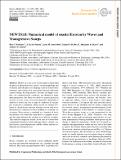NEWTS1.0: Numerical model of coastal Erosion by Waves and Transgressive Scarps
Author(s)
Palermo, Rose V; Perron, J Taylor; Soderblom, Jason M; Birch, Samuel PD; Hayes, Alexander G; Ashton, Andrew D; ... Show more Show less
DownloadPublished version (6.519Mb)
Publisher with Creative Commons License
Publisher with Creative Commons License
Creative Commons Attribution
Terms of use
Metadata
Show full item recordAbstract
Models of rocky-coast erosion help us understand the physical phenomena that control coastal morphology and evolution, infer the processes shaping coasts in remote environments, and evaluate risk from natural hazards and future climate change. Existing models, however, are highly complex, are computationally expensive, and depend on many input parameters; this limits our ability to explore planform erosion of rocky coasts over long timescales (thousands to millions of years) and over a range of conditions. In this paper, we present a simplified cellular model of coastline evolution in closed basins through uniform erosion and wave-driven erosion. Uniform erosion is modeled as a constant rate of retreat. Wave erosion is modeled as a function of fetch, the distance over which the wind blows to generate waves, and the angle between the incident wave and the shoreline. This reduced-complexity model can be used to evaluate how a detachment-limited coastal landscape reflects climate, sea-level history, material properties, and the relative influence of different erosional processes.
Date issued
2024Department
Massachusetts Institute of Technology. Department of Earth, Atmospheric, and Planetary Sciences; Joint Program in OceanographyJournal
Geoscientific Model Development
Publisher
Copernicus GmbH
Citation
Palermo, R. V., Perron, J. T., Soderblom, J. M., Birch, S. P. D., Hayes, A. G., and Ashton, A. D.: NEWTS1.0: Numerical model of coastal Erosion by Waves and Transgressive Scarps, Geosci. Model Dev., 17, 3433–3445.
Version: Final published version